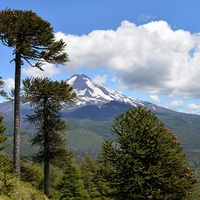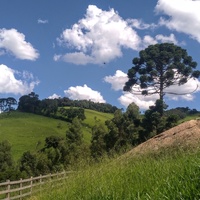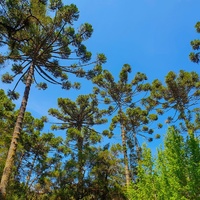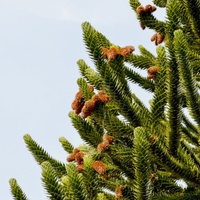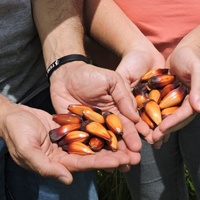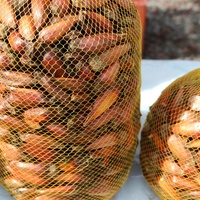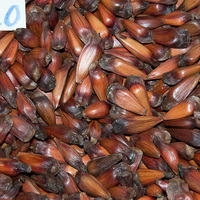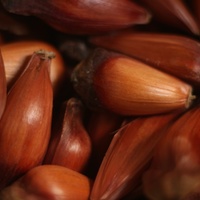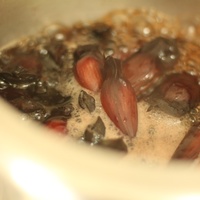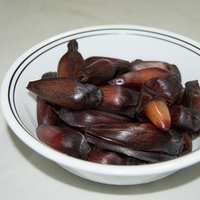Common name: Brazilian pine
Other common names: Candelabra tree, Paraná pine
Description
Brazilian Pine or Paraná Pine is a timber and nut-bearing conifer native to subtropical parts of southern Brazil.
A large tree, it may reach heights of up to 50 m (165 ft), though it is more typically 24 to 36 m (80 to 118 ft) tall.
Branching starts low on the trunk on young trees, forming a pyramidal crown. As the tree ages, it self-prunes its lower branches, progressively exposing more of the trunk. By the time the tree reaches maturity, only a few branches remain, which are high on the trunk near the top, forming a candelabra-shaped crown. The bark is grey to grey-brown and rough.
Leaves are dark green, triangular-shaped, 3 to 6 cm (1 to 2 in) long, sharply pointed and arranged spirally along the ends of the branches. They remain on the tree in all seasons.
Brazilian Pine bears female and male cones on separate trees. Cones on male trees are elongated oval, up to 10.6 cm (4 in) long and produce pollen that gets carried on the wind to fertilise the cones on female trees. The female cones are large, rounded, close to a football in shape and size and have a green weight of around 3 to 4 kg (7 to 9 lbs). They take two to three years to reach full maturity, becoming rust-brown and containing many sizeable egg-shaped seed.
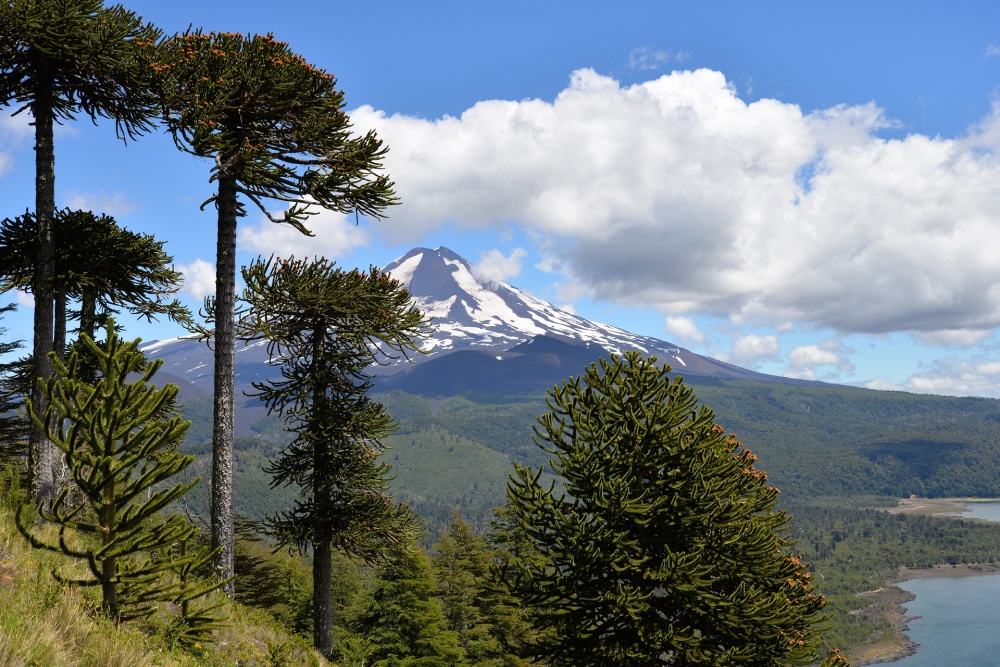
Photo by Patricio Hurtado from Pixabay
Use
The mature cones contain large, edible seed kernels, each around 4 to 7 cm (1.5 to 2.8 in) long and with an elongated egg shape. Being tasty and nutritious, they are a popular nut in Brazil's south, either roasted or boiled in their skin then peeled and eaten.
Brazilian Pine produces a light- to medium-weight wood, averaging at around 550 kilograms per cubic meter (34 lbs per cubic ft), with low natural resistance to rot and decay. This classes it as a non-durable softwood, which limits its use outdoors. The heartwood is yellowish-white to pale-brown, usually with attractive red streaking.
Large, well-formed logs are sawn into planks used in light construction, joinery work and for making furniture and cabinets, or are sliced into sheets for decorative veneer and plywood. Small diameter logs are cut for fence posts and tall transmission poles for carrying electricity and communication cables. They are also processed into pulp for making paper and manufactured woods such as particleboard.
It is listed as a critically endangered tree species by the International Union for Conservation of Nature and Natural Resources (IUCN), bringing attention to its conservation needs.
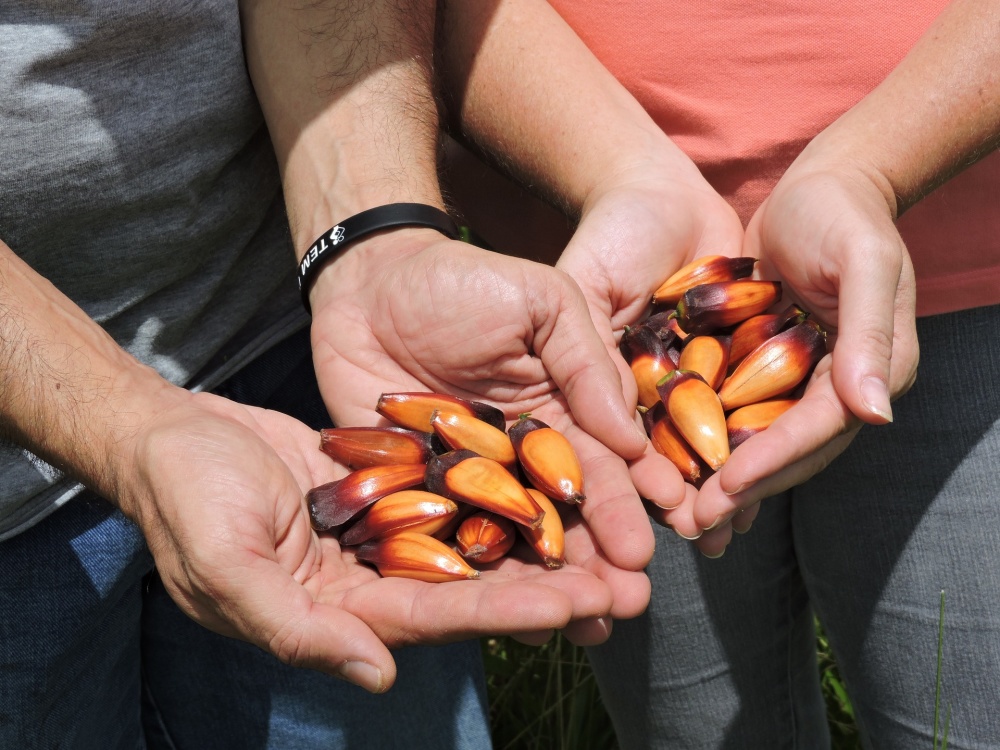
Photo by joapereira from Pixabay
Climate
Although naturally adapted to humid subtropical climates, Brazilian Pine also grows well in warm-temperate to tropical highland climates, generally areas with annual lows of 10 to 17°C, annual highs of 17 to 28°C, annual rainfall of 900 to 2600 mm and a dry season of 3 months or less.
Growing
New plants are usually started from seed, but these lose their viability quickly and are best when sown within three to four weeks after extracting from the cone. Alternately, they can be stored for for extended periods in sealed containers under cool, dry, air-tight conditions. Seed for sowing should only be sourced from freshly fallen cones, which helps ensure their viability.
Performs best on deep, rich, moist, free-draining clay, loam or sand soils of a moderately acid to neutral nature, generally with a pH of 5.5 to 7.5, and on sites with full to partial sun exposure.
Problem features
The seed are heavy and not easily dispersed by birds but are know to be dispersed by ground-dwelling animals, including rodents. It is listed in at least one reference publication as a weed somewhere in the world. Still, there does not appear to be any records of it naturalising or becoming a serious weed.
The leaves have sharp points that can inflict pain or injury if handled.
Where it grows
References
Books
-
Berni, C. A & Bolza, E. & Christensen, F. J. 1979, South American timbers - the characteristics, properties and uses of 190 species, Commonwealth Scientific and Industrial Research Organization (CSIRO), Division of Building Research, Highett, Victoria, Australia
-
Bonner, F. T & Karrfalt, R. P. 2008, The woody plant seed manual, U.S. Department of Agriculture, Forest Service, Washington D.C.
-
Chudnoff, M. 1984, Tropical timbers of the world, Forest Service, U.S. Department of Agriculture (USDA), Washington, D.C.
-
Food and Agriculture Organization of the United Nations (FAO) 1986, Databook on endangered tree and shrub species and provenances, FAO Forestry Paper 77, Forest Resources Division, Rome
-
Howes, F. N. 1949, Vegetable gums and resins, Chronica Botanica Company, Waltham, Massachusetts
-
Jex-Blake, A. J. 1957, Gardening in East Africa : a practical handbook, 4th ed., Royal Kenya Horticultural Society, Longmans, Green and Company, London
-
Liegel, L. H. 1987. A technical guide for forest nursery management in the Caribbean and Latin America, U.S. Dept. of Agriculture, Forest Service, Southern Forest Experiment Station, New Orleans
-
Little, E. L. & Skolmen, R. G. 1989, Common forest trees of Hawaii (native and introduced), Agricultuural Handbook No. 679, Forest Service, U.S. Department of Agriculture, Washington, D.C.
-
Lorenzi, H. 2002, Brazilian trees : a guide to the identification and cultivation of Brazilian native trees. Vol. 1, 4. ed, Instituto Plantarum de Estudos da Flora, Nova Odessa, Sao Paulo
-
Martin, F. M., et al. 1987, Perennial edible fruits of the tropics : an inventory, U.S. Dept. of Agriculture (USDA), Agricultural Research Service, U.S. Government Printing Office (GPO), Washington, D.C.
-
Menninger, E. A. 1977, Edible nuts of the world, Horticultural Books, Stuart, Florida
-
Ntima, O. O. 1968, The araucarias, Commonwealth Forestry Institute, University of Oxford, Oxfordshire
-
Randall, R. P. 2002, A global compendium of weeds, R.G. and F.J. Richardson Press, Melbourne
-
Randall, R. P. 2007, The introduced flora of Australia and its weed status, Cooperative Research Centre for Australian Weed Management, Glen Osmond, South Australia
-
Record, S. J. & Hess, R. W., 1972, Timbers of the New World, Yale University Press, New Haven, Connecticut & Arno Press, New York
-
Scheffer, T. C & Morrell, J. J. 1998, Natural durability of wood : a worldwide checklist of species, Forest Research Laboratory, Oregon State University, Corvallis, Oregon
-
Stewart, A. 2013, The drunken botanist : the plants that create the world's great drinks, 1st ed., Algonquin Books, Chapel Hill, North Carolina
-
Webb, D. B. 1984, A Guide to species selection for tropical and sub-tropical plantations, 2nd ed., Unit of Tropical Silviculture, Commonwealth Forestry Institute, University of Oxford, Oxfordshire
-
Whitesell, C. D. & Walters, G. A. 1976, Species adaptability trials for man-made forests in Hawaii. Research Paper PSW-RP-118, U.S. Department of Agriculture, Forest Service, Pacific Southwest Forest and Range Experiment Station, Hawaii
